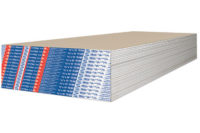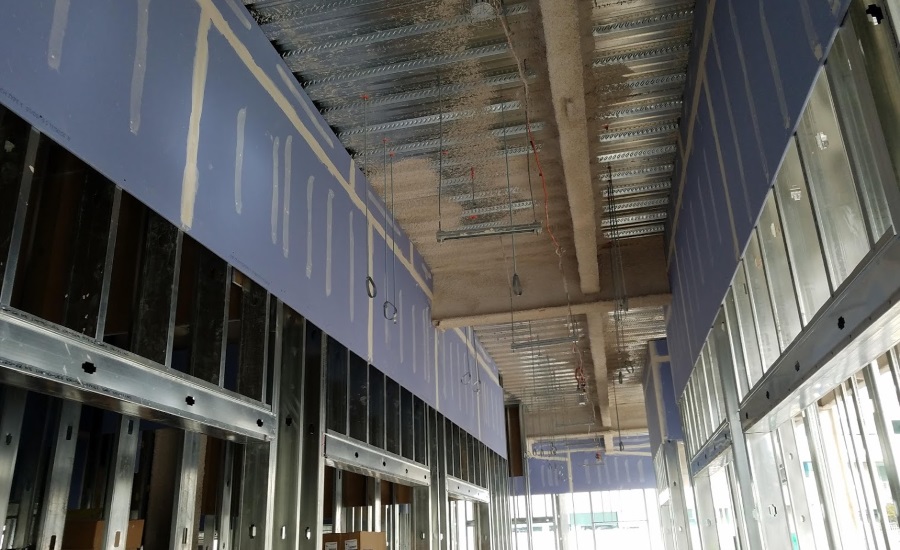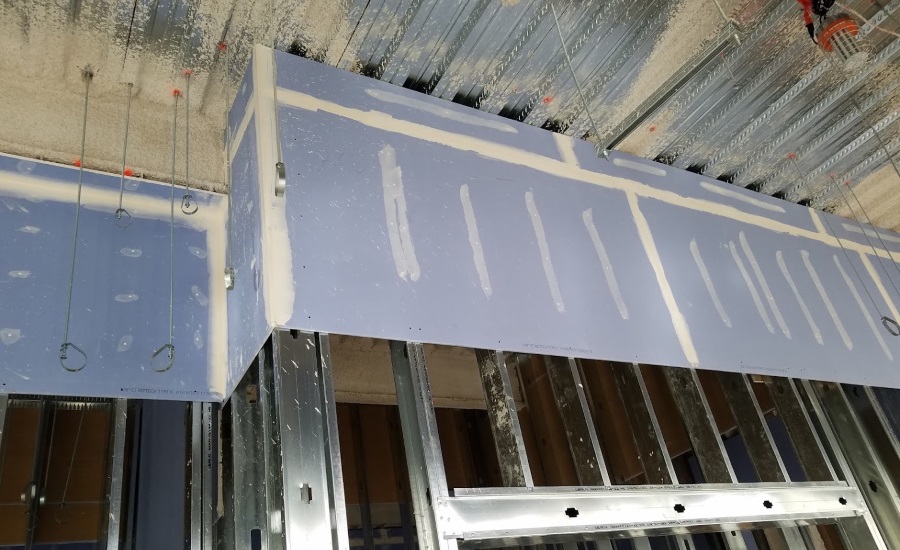Top-Down Gypsum Board Installation
By Terry Kastner




In commercial building construction, the flow or sequence of critical work is relatively consistent. It typically begins with excavation and foundation work, followed by the supporting or superstructure, floors and roof. Immediately following the completion of floors is the framing of interior corridors or “interference” wall framing. There are basically two types of interior wall framing: primary, corridor or interference walls; and secondary, or partition walls. The corridor or interference walls are defined as walls that must be installed, before any of the mechanical (HVAC, ductwork), main electrical conduits, plumbing, and, in most cases, fire-suppression piping (collectively referred to as MEP). Top-Down wallboard is the installation of gypsum wallboard to both sides of a partition, extending from the underside of structure, top of partition, and down to a point below any and all interfering MEP installations. The reason these walls must be installed first, including top-down gypsum wallboard, is because the MEP installations will block access to these walls, affecting life-safety of the partitions, and safety hazards for tradespersons. “Interior walls are topped out before MEPs are in place to minimize obstructions to access these hard-to-reach areas by drywall craft workers” (Source: AGC 2018 CSEA Safety Management Best Practices).
Therefore, the sequence of the installations must be:
- Framing
- Inspection approval
- Top-down gypsum wallboard
- Inspection approval
- MEP installations
Top-Down sequencing is recognized throughout the Industry as a best practice and described in white papers such as that provided by United States Gypsum (USG), PRE DRY-IN CONSTRUCTION: The Evolution of Construction Starts from Within, which states: “A significant development in the drywall industry has been the introduction of what is known as “pre-rock, “top-down” or “topping-out” construction. All of these terms refer to installing some portion of drywall “pre dry-in,” well in advance of closing up the structure and making it weather tight as in conventional industry practice….Pre dry-in construction entails coordinating the trades so that the Drywall trade installs the interior metal framing and then hangs drywall only in the plenum above the finished ceiling plane before the Mechanical, Electrical and Plumbing (MEP) trades install ducts, conduit and pipes that penetrate the plenum walls….Installing metal framing and drywall ahead of MEP requires that drywall be hung before the building has been fully closed in. Therefore, the interior construction is not protected from weather for a period of time. Restricting this practice to the plenum space above the ceiling plane provides partial protection from weather exposure from the roof or floor above, and also ensures that water will not collect and pool where it will be in direct contact with the gypsum panels. However, the panels at the perimeter are more exposed to the elements. As such, standard paper-faced gypsum board is not suitable for these limited outdoor exposures and special mold and water-resistant gypsum panels should always be used for this application.”
For top-down gypsum wallboard installation, prior to complete enclosure of the structure, the Northwest Wall and Ceiling Bureau recommends that mold- and-water resistant gypsum board products be substituted for standard gypsum wallboard. All major gypsum board manufacturers provide mold- and moisture-resistant gypsum panels, whether they are paper-faced products that have specially formulated mold- and moisture-resistant face paper and back papers, or Glass-Mat gypsum panel products. Both types of gypsum panels may be used in top-down construction provided they are afforded minimal protection from water runoff, which is typically generated by overhead floor construction.
Coordination with the MEP trades and building inspectors, prior to commencing top-down activities, is essential. As noted in the installation sequencing described above, the building inspector will perform a framing inspection and approve top-down wallboard installations, to be performed prior to the installation of any interfering MEP installations. If MEP are scheduled to be installed through slap and within the wall cavity, the sleeves, pipe or conduit, shall be installed prior to top-down wallboard but shall not interfere with the installation of top-down wallboard.
In many cases topping-out activities also require that the wallboard joints and fasteners for gypsum panels be fire-taped, which generally involves the use of drying-type joint compounds. As noted above, drying- type compounds require a minimum temperature of 50ºF. If temperatures are forecasted to be at or above the minimum prescribed temperature, drying compounds, which cure through evaporation of the liquid in the compound, may be utilized. If temperatures are forecasted to below 50ºF, setting compounds are recommended. Setting compounds cure through a chemical process and are not as sensitive to temperature variations that may affect drying compounds. Setting type compounds cure within as little as 20 minutes, 60 minutes or 90 minutes and may be used for fire-taping, provided the setting compounds set before the temperature reaches 32ºF.
Although ASTM C840 the Standard Specification for Application and Finishing of Gypsum Board Section 4 – Environmental Conditions, Sub-Section 4.1 Application of Gypsum Board, Joint Treatment Materials, and Adhesives, implies that the minimum temperature for the installation of gypsum board must be: “Room temperature shall be maintained at not less than 40 ºF (4 ºC) during application of gypsum board except when adhesive is used for the attachment of gypsum board…..” The overriding intent of Section 4 is to ensure proper environmental conditions for the curing of the weather-sensitive materials associated with the installation of gypsum board, including drying taping compounds, adhesives, textures and decoration. The attachment of gypsum board in temperatures less than 40 ºF does not affect the performance of gypsum board provided the gypsum is afforded protection from direct contact to moisture.
Looking for a reprint of this article?
From high-res PDFs to custom plaques, order your copy today!









